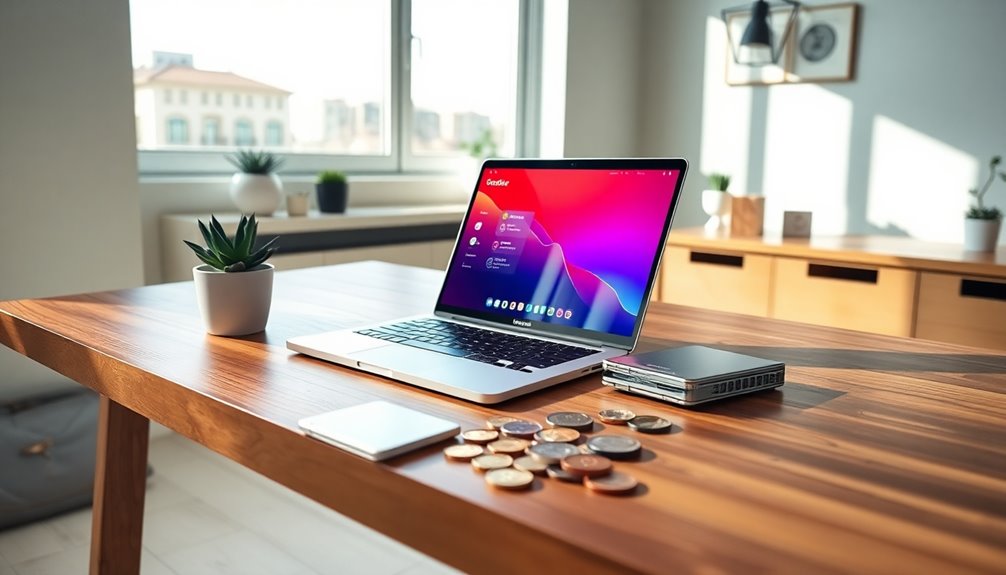Self-custodial wallets give you complete control over your cryptocurrency assets, enhancing security and flexibility. You can choose from different types, like software wallets for daily transactions, hardware wallets for long-term storage, or even paper wallets for offline security. In these wallets, you own your private keys, which allows participation in decentralized finance (DeFi) and ensures your privacy. However, managing your private keys and backups requires responsibility and some technical know-how. Understanding the various features and security measures can help optimize your experience. There's much more to discover about maximizing your self-custodial wallet use.
Key Takeaways
- Self-custodial wallets provide users full control over their cryptocurrency assets, enhancing security and privacy through local key storage.
- Different wallet types, including software, hardware, and paper wallets, cater to varying transaction needs and security preferences.
- Multi-factor authentication and encryption of private keys are essential security measures to protect against unauthorized access.
- Users must manage their private keys and backups, as loss may result in irreversible access to funds.
- Regular backups and secure recovery phrases are crucial for asset recovery, ensuring continued access to funds in emergencies.
Key Features and Functions
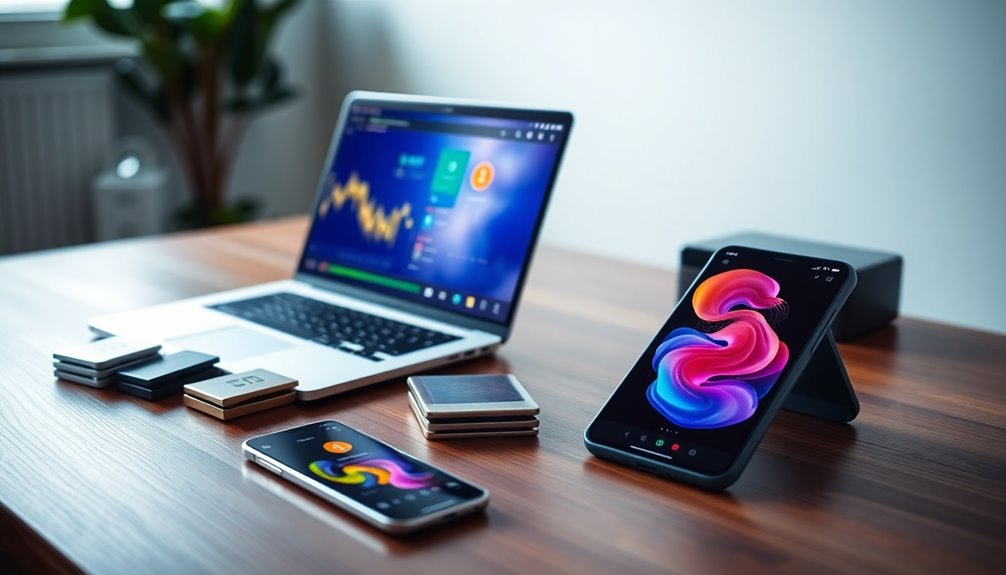
When you choose a self-custodial wallet, you gain complete ownership of your cryptocurrencies, as you hold your private keys. This means no third-party can access your assets, granting you true ownership similar to physical cash. You're responsible for safeguarding your keys, but this also means you face no restrictions from external entities.
With enhanced security features, your private keys are stored locally, making them less vulnerable to hacks. You can implement strong security measures like 2FA, encryption, and biometric locks. Additionally, the use of cold wallets further reduces the risk of online threats.
You control all transactions directly, enjoying permissionless access to your funds. Plus, self-custodial wallets often come with intuitive interfaces, multi-blockchain compatibility, and real-time portfolio tracking, making them both functional and user-friendly.
Self-Custody Wallet Overview
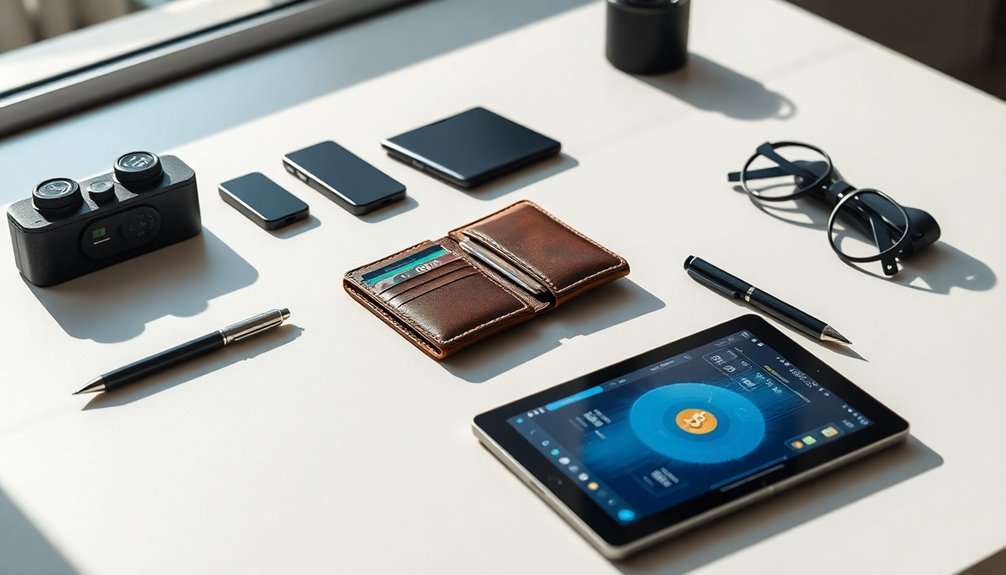
Self-custodial wallets empower you to take full control of your cryptocurrency assets, allowing for greater flexibility and security.
You can choose from various types, including software wallets like MetaMask and Trust Wallet for easy access, hardware wallets like Trezor and Ledger for enhanced safety, or paper wallets for offline storage. Each type has its strengths; software wallets are great for frequent transactions, while hardware wallets offer superior protection against online threats. To enhance your security, consider using non-custodial wallets, which provide complete control over your private keys and reduce the risk of third-party fraud.
To maximize security, use strong passwords, enable two-factor authentication, and keep your seed phrase offline.
Research reputable wallet providers and always be cautious of scams. With self-custody, you enjoy full ownership, privacy, and the ability to participate in decentralized finance without relying on third parties.
Transaction Verification Process
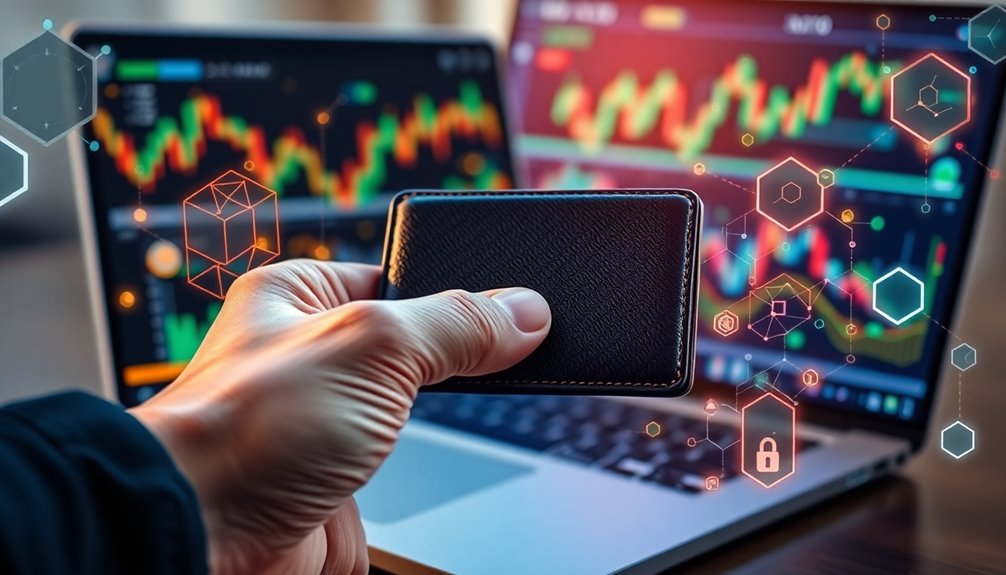
Verifying transactions is a critical step in ensuring the security of your funds when withdrawing from a Virtual Asset Service Provider (VASP) to your self-custody wallet.
First, you initiate the withdrawal by providing your wallet's public address. Next, the VASP requires verification, which can involve several methods.
You might perform a Satoshi Test to confirm control over the address or use Manual Signing if your wallet supports it. Alternatively, the Address Ownership Proof Protocol (AOPP) automates the process, enhancing efficiency. This protocol helps to streamline the verification process for VASPs, reducing the potential for errors.
Each method has its strengths, but automated options like AOPP reduce the risk of errors and fraud. Once verified, the VASP confirms your transaction, allowing you to receive your funds securely.
Pros and Cons Summary
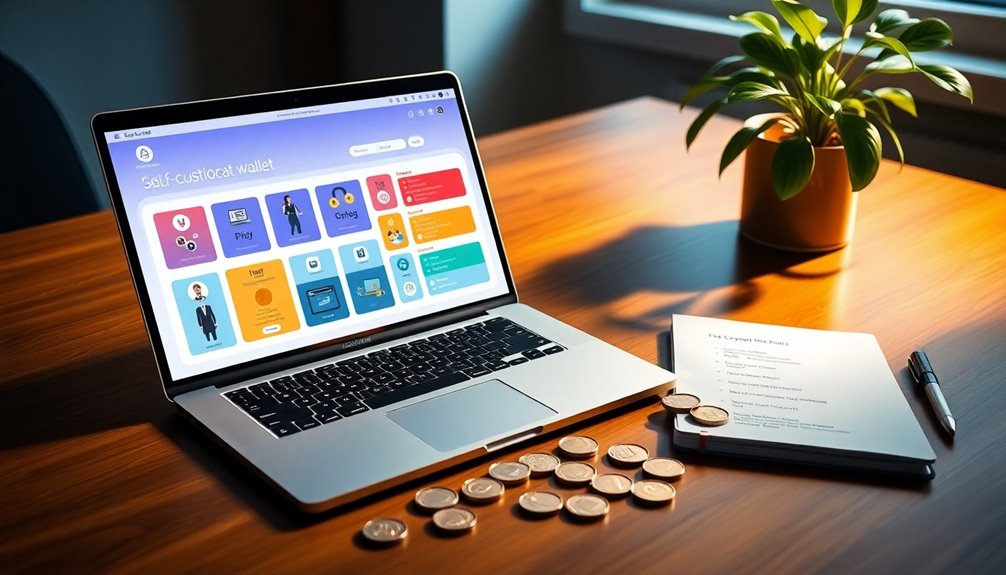
After ensuring your transactions are secure, it's important to weigh the benefits and drawbacks of using self-custodial wallets.
On the plus side, you gain complete control over your funds, enhancing security and privacy. You won't deal with third-party restrictions or KYC procedures, allowing for greater autonomy and lower fees. Additionally, self-custody wallets provide the ability to engage with decentralized applications, expanding your options for using cryptocurrencies.
However, this responsibility comes with challenges. You must manage your private keys and backups, risking irreversible loss if mishandled. The complexity can be daunting, especially for beginners, and you won't have customer support for recovery issues.
Additionally, technical expertise may be necessary, making accessibility a concern. Balancing these pros and cons will help you decide if a self-custodial wallet is right for you.
Wallet Types Comparison
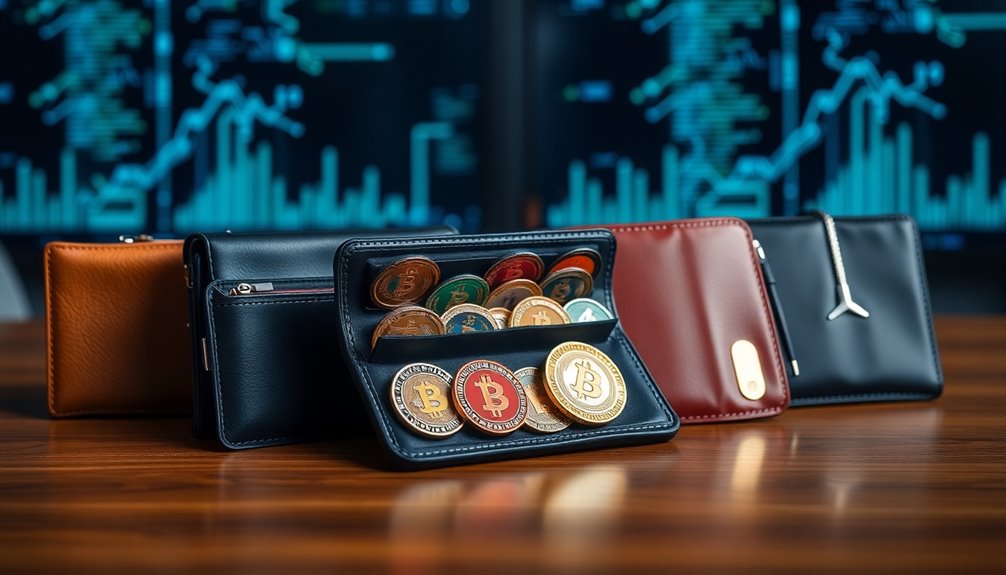
Choosing the right wallet type is crucial for managing your cryptocurrency effectively.
Hardware wallets offer offline storage, keeping your private keys safe from online threats. They're perfect for long-term storage and often support multi-signature features. Additionally, it's important to remember that losing your private keys can result in the permanent loss of access to your funds.
On the other hand, software wallets are digital applications that provide convenience and multi-chain support, making them ideal for frequent transactions and DeFi activities. They also integrate well with Web3 platforms.
Lastly, paper wallets deliver high security as offline documents but are fragile and require careful manual management.
Each wallet type has distinct advantages, so consider your needs—whether it's security, convenience, or storage duration—before making a decision. Your choice will impact how you interact with your crypto assets.
Security Vulnerabilities and Hacks

While selecting the right wallet type is important for managing your cryptocurrency, understanding the potential security vulnerabilities and hacks that can jeopardize your assets is equally vital.
Losing your private keys or seed phrases means irreversible fund loss, so proper key management is crucial. Always store physical copies in secure locations, avoiding digital storage to reduce hack risks. Self-custody wallets ensure exclusive control over your private keys, emphasizing the importance of safeguarding them.
Human error, like using weak passwords or storing keys on compromised devices, is another common vulnerability. Enable two-factor authentication for added security.
Software wallets can be hacked if your device is compromised, so keep your software updated.
Be vigilant against phishing attacks—never share your private keys or seed phrases, and always verify links and sources to avoid scams.
Decentralized Finance (DeFi) Integration

As you explore the world of self-custodial wallets, integrating with Decentralized Finance (DeFi) applications can significantly enhance your cryptocurrency experience.
These wallets allow you to manage digital assets in a decentralized environment, giving you direct access to blockchain networks without intermediaries. You can seamlessly interact with various DeFi protocols, performing actions like staking, token trading, borrowing, and lending. Additionally, these wallets typically feature user-controlled private keys, ensuring that you maintain full ownership and security of your assets.
With multi-chain compatibility, you can trade and store a wide range of cryptocurrencies from different blockchains, including Ethereum and TRON.
Plus, built-in DApp browsers make it easy to access NFT marketplaces and participate in yield farming.
Regular Software Updates
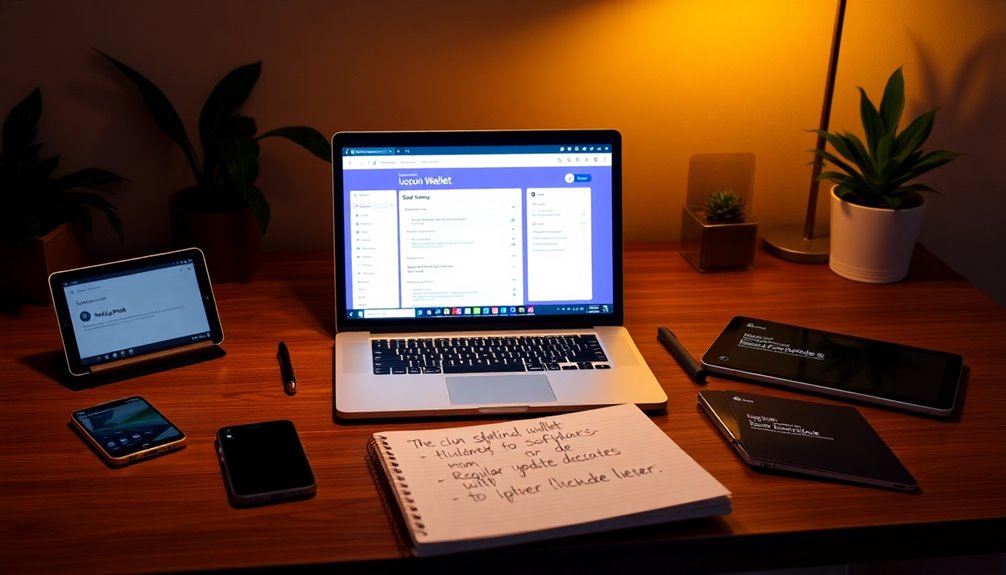
Regular software updates are crucial for maintaining the security and functionality of your self-custodial wallet. They not only fix security bugs and vulnerabilities but also introduce new features that enhance your wallet's protection against cyber threats.
By keeping your software updated, you reduce the risk of scams and ensure your private keys remain safe. Updates also improve your overall user experience, streamlining transaction management and adding support for more cryptocurrencies. Additionally, they help maintain effective backup and recovery procedures, ensuring you can easily access your assets if your primary device is lost.
In short, staying current with software updates is essential for safeguarding your funds and optimizing your wallet's performance. This is especially important as self-custodial wallets are increasingly recognized for their role in enhancing user security and privacy in the crypto space.
Frequently Asked Questions
How Do I Recover My Wallet if I Lose My Keys?
If you've lost your keys, don't worry. You can recover your wallet using your recovery phrase or seed phrase, which is a series of 12 to 24 words.
Simply re-download the wallet app and enter your seed phrase. If you've set up designated recoverers or guardians, they can assist with recovery too.
Always store your recovery phrase securely and never share it, as it grants access to your wallet.
Can I Use Multiple Self-Custodial Wallets Simultaneously?
Yes, you can use multiple self-custodial wallets simultaneously.
You can organize your assets by allocating specific wallets for savings, payments, and investments. You can enhance your security by distributing your assets, limiting exposure in case of loss.
You can also track different types of transactions, keeping your financial activities clear and structured.
What Is the Best Practice for Storing My Recovery Phrase?
To store your recovery phrase securely, write it down on paper and keep it in a safe, fireproof location.
Consider using durable materials like metal plates for added protection.
Don't store it digitally, like in emails or screenshots, to avoid hacking risks.
Create multiple copies and place them in different secure spots.
Regularly check their security, and remember, never share your recovery phrase with anyone to maintain confidentiality and access control.
Are Self-Custodial Wallets Compatible With All Cryptocurrencies?
When it comes to self-custodial wallets, you can't fit a square peg in a round hole. Not all wallets support every cryptocurrency.
Some wallets, like Exodus and Trust Wallet, cover a wide range, including major players like Bitcoin and Ethereum. However, others may only manage a limited selection.
Before you dive in, check the compatibility of your chosen wallet with the cryptocurrencies you intend to store or trade.
How Can I Transfer Assets Between Different Self-Custodial Wallets?
To transfer assets between different self-custodial wallets, start by downloading and setting up the destination wallet.
Retrieve its receiving address and ensure the asset's compatibility.
Open your source wallet, select the "Send" option, and enter the amount along with the recipient address.
Review the transaction details for accuracy and finalize it.
After completing the transfer, verify the transaction on the blockchain and check the destination wallet's balance to confirm receipt.
Conclusion
In summary, self-custodial wallets empower you to protect your precious assets while promoting personal privacy. By understanding their features and flaws, you can confidently navigate the crypto landscape. Remember, staying savvy about security and integrating with DeFi can enhance your experience. So, as you embark on your digital journey, prioritize proper practices to safeguard your stash, and you'll ensure a seamless, secure, and satisfying self-custody strategy. Happy holding!
